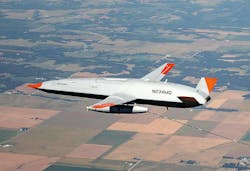Navy asks Boeing to build another two developmental MQ-25 unmanned aerial tanker aircraft and avionics
PATUXENT RIVER NAS, Md. – U.S. Navy carrier aviation experts are ordering two unmanned aerial tankers from the Boeing Co. in preparation for future larger orders and eventual carrier deployment of these unmanned tanker aircraft.
Officials of the Naval Air Systems Command at Patuxent River Naval Air Station, Md., announced an $657.1 million order to the Boeing Co. Defense, Space & Security segment in St. Louis in late March for the fourth and fifth demonstration versions of the MQ-25 Stingray unmanned carrier-based aerial tanker.
The MQ-25 refueling tanker is the U.S. Navy's first operational carrier-based unmanned aircraft and is designed to provide a much-needed carrier aircraft refueling capability, Boeing officials say. Navy officials expect to declare MQ-25 initial operational capability sometime this year. The MQ-25 first flew in September 2019.
The MQ-25 will provide aircraft carrier-based refueling to extend the range of deployed F/A-18 Super Hornet, EA-18G Growler, and Lockheed Martin F-35C combat aircraft.
Boeing won a $805 million development contract to build four MQ-25 carrier-based unmanned aerial tankers in 2018, prevailing over competing designs built by General Atomics in San Diego and the Northrop Grumman Corp. Aeronautics Systems segment in Palmdale, Calif.
The Boeing MQ-25 aircraft has an advanced, customized remote I/O interface controller based from Aitech Defense Systems Inc. in Chatsworth, Calif. The system is based on the Aitech Ai-RIO avionics remote interface.
The Ai-RIO is expandable with as many as eight units networked together. Added capabilities include I/O, power switching, and mass/SD FLASH memory. The remote I/O subsystem includes a Gigabit Ethernet port with precision time sync IEEE-1588 support, 10 RS-422 ports, eight LVDS or RS-422/485 UARTS, four SpaceWire ports with LVDS I/O, two CANbus ports, and 16 GPIO in two blocks of eight.
The Ai-RIO is an high density, low power rugged subsystem for vehicle platform flight control, attitude and navigation controls, servo-valve and thrust vector control (TVC), robotic motor control, video and image processing and storage, data telemetry, platform stabilization, communications and telematics, high speed data recorders, booster and launch propulsion and thruster control, remote sensor and effector monitoring.
Boeing can use the Ai-RIO as a stand-alone command and data handling platform or networked remote command/response I/O unit. It a radiation-qualified dual-core PowerPC processor with two rad-tolerant FPGAs. All internal electronics are conduction-cooled and mechanically fixed and housed within a sealed, EMI/EMC Faraday cage for maximum thermal transfer.
In addition to Aitech, other subcontractors to Boeing on the MQ-25 project are; BAE Systems; Collins Aerospace; Cox & Co.; Crane Aerospace & Electronics; Cubic; Curtiss-Wright Defense Solutions; General Electric Corp.; L3Harris Technologies; Héroux-Devtek; Honeywell International; Innovative Power Solutions; Moog Aircraft Group; Parker Hannifin; Raytheon; Rolls-Royce; and Triumph Group.
On this order Boeing will do the work in St. Louis; Goleta, San Diego, Torrance, and Irvine, Calif.; Endicott, N.Y.; Malabar and Clearwater, Fla.; Indianapolis; Longueuil, Quebec; Cedar Rapids, Iowa; and other locations, and should be finished by October 2028.
For more information contact Boeing Defense, Space & Security online at www.boeing.com/defense/mq25, Aitech Defense Systems at https://aitechsystems.com/news-ai-rio-subsystem-linux/, or Naval Air Systems Command at www.navair.navy.mil.

John Keller | Editor-in-Chief
John Keller is the Editor-in-Chief, Military & Aerospace Electronics Magazine--provides extensive coverage and analysis of enabling electronics and optoelectronic technologies in military, space and commercial aviation applications. John has been a member of the Military & Aerospace Electronics staff since 1989 and chief editor since 1995.

